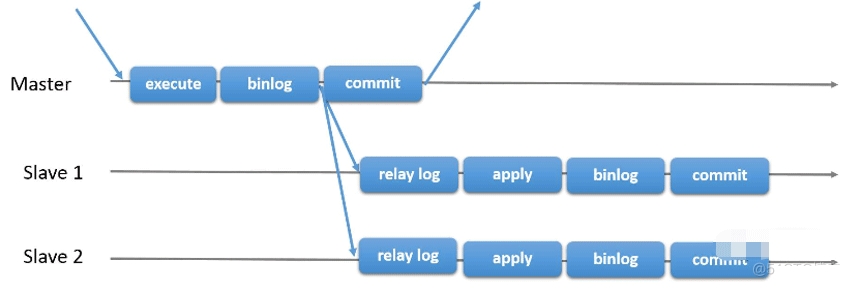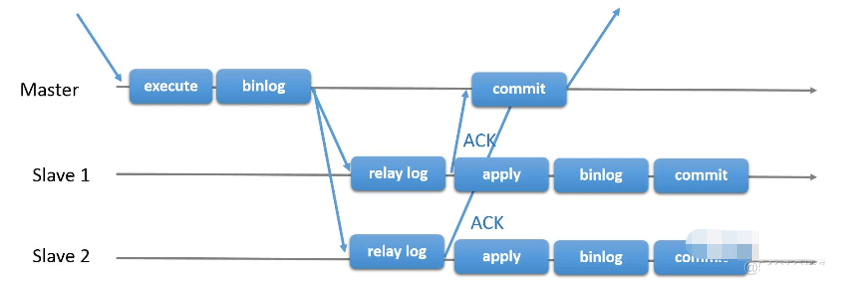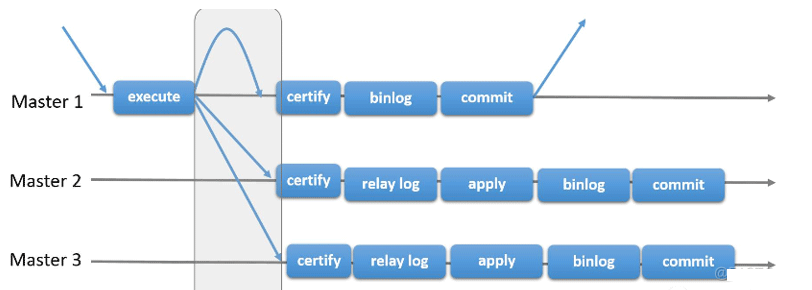What are the three replication modes of Mysql master and slave?
MySQL Asynchronous Replication
MySQL asynchronous replication is the default replication mode during the master-slave replication process. Replication involves three threads, including the master I/O thread, the slave I/O thread, and the slave SQL thread. Because it is asynchronous replication, the submission of the master transaction does not need to be confirmed by the slave. That is, after the master I/O thread submits the transaction, it does not need to wait for the reply confirmation from the slave I/O thread. The master does not guarantee that the binlog will be written to the relay. in the log; after slave I/O writes the binlog to the relay log, it is asynchronously executed by the slave sql thread and applied to slave mysql. Slave I/O does not require reply confirmation from slave sql, and does not guarantee that the relay log is completely written. In mysql.

Semi-synchronous replication
In order to make up for the shortcomings of traditional asynchronous replication, MySQL introduced semi-synchronous replication in version 5.5, which is an improvement over traditional asynchronous replication. . Before the master transaction is committed, it must be ensured that the binlog log has been written to the slave's relay log. Only after receiving the response from the slave to the master can the transaction be committed. Despite this, the second half of the relay log will still be passed to the sql thread for execution asynchronously.


Data consistency guarantee:Ensure that most nodes in the cluster receive logs
Node writing support: In multi-write mode, all nodes in the cluster can be written (but considering the 1 to high concurrency scenario to ensure high data consistency, production does not choose multi-master writing, use single master Cluster)
Fault Tolerance: Ensure that the system is still available when it fails (including split brain), and double writing has no impact on the system
The current impact of MGR's solution- Only supports InnoDB tables, and each table must have a primary key for conflict detection of write set;
- The GTID feature must be turned on , the binary log format must be set to ROW, used for primary selection and write set
- COMMIT may cause failure, similar to the failure scenario of the snapshot transaction isolation level
- Currently, an MGR cluster supports up to 9 nodes
- Does not support foreign keys and save point features, and cannot perform global constraint detection and partial rollback
- Binary log does not support binlog event checksum
The above is the detailed content of What are the three replication modes of Mysql master and slave?. For more information, please follow other related articles on the PHP Chinese website!

Hot AI Tools

Undresser.AI Undress
AI-powered app for creating realistic nude photos

AI Clothes Remover
Online AI tool for removing clothes from photos.

Undress AI Tool
Undress images for free

Clothoff.io
AI clothes remover

AI Hentai Generator
Generate AI Hentai for free.

Hot Article

Hot Tools

Notepad++7.3.1
Easy-to-use and free code editor

SublimeText3 Chinese version
Chinese version, very easy to use

Zend Studio 13.0.1
Powerful PHP integrated development environment

Dreamweaver CS6
Visual web development tools

SublimeText3 Mac version
God-level code editing software (SublimeText3)

Hot Topics
 PHP's big data structure processing skills
May 08, 2024 am 10:24 AM
PHP's big data structure processing skills
May 08, 2024 am 10:24 AM
Big data structure processing skills: Chunking: Break down the data set and process it in chunks to reduce memory consumption. Generator: Generate data items one by one without loading the entire data set, suitable for unlimited data sets. Streaming: Read files or query results line by line, suitable for large files or remote data. External storage: For very large data sets, store the data in a database or NoSQL.
 How to use MySQL backup and restore in PHP?
Jun 03, 2024 pm 12:19 PM
How to use MySQL backup and restore in PHP?
Jun 03, 2024 pm 12:19 PM
Backing up and restoring a MySQL database in PHP can be achieved by following these steps: Back up the database: Use the mysqldump command to dump the database into a SQL file. Restore database: Use the mysql command to restore the database from SQL files.
 How to optimize MySQL query performance in PHP?
Jun 03, 2024 pm 08:11 PM
How to optimize MySQL query performance in PHP?
Jun 03, 2024 pm 08:11 PM
MySQL query performance can be optimized by building indexes that reduce lookup time from linear complexity to logarithmic complexity. Use PreparedStatements to prevent SQL injection and improve query performance. Limit query results and reduce the amount of data processed by the server. Optimize join queries, including using appropriate join types, creating indexes, and considering using subqueries. Analyze queries to identify bottlenecks; use caching to reduce database load; optimize PHP code to minimize overhead.
 How to insert data into a MySQL table using PHP?
Jun 02, 2024 pm 02:26 PM
How to insert data into a MySQL table using PHP?
Jun 02, 2024 pm 02:26 PM
How to insert data into MySQL table? Connect to the database: Use mysqli to establish a connection to the database. Prepare the SQL query: Write an INSERT statement to specify the columns and values to be inserted. Execute query: Use the query() method to execute the insertion query. If successful, a confirmation message will be output.
 How to create a MySQL table using PHP?
Jun 04, 2024 pm 01:57 PM
How to create a MySQL table using PHP?
Jun 04, 2024 pm 01:57 PM
Creating a MySQL table using PHP requires the following steps: Connect to the database. Create the database if it does not exist. Select a database. Create table. Execute the query. Close the connection.
 How to use MySQL stored procedures in PHP?
Jun 02, 2024 pm 02:13 PM
How to use MySQL stored procedures in PHP?
Jun 02, 2024 pm 02:13 PM
To use MySQL stored procedures in PHP: Use PDO or the MySQLi extension to connect to a MySQL database. Prepare the statement to call the stored procedure. Execute the stored procedure. Process the result set (if the stored procedure returns results). Close the database connection.
 How to fix mysql_native_password not loaded errors on MySQL 8.4
Dec 09, 2024 am 11:42 AM
How to fix mysql_native_password not loaded errors on MySQL 8.4
Dec 09, 2024 am 11:42 AM
One of the major changes introduced in MySQL 8.4 (the latest LTS release as of 2024) is that the "MySQL Native Password" plugin is no longer enabled by default. Further, MySQL 9.0 removes this plugin completely. This change affects PHP and other app
 The difference between oracle database and mysql
May 10, 2024 am 01:54 AM
The difference between oracle database and mysql
May 10, 2024 am 01:54 AM
Oracle database and MySQL are both databases based on the relational model, but Oracle is superior in terms of compatibility, scalability, data types and security; while MySQL focuses on speed and flexibility and is more suitable for small to medium-sized data sets. . ① Oracle provides a wide range of data types, ② provides advanced security features, ③ is suitable for enterprise-level applications; ① MySQL supports NoSQL data types, ② has fewer security measures, and ③ is suitable for small to medium-sized applications.






